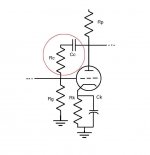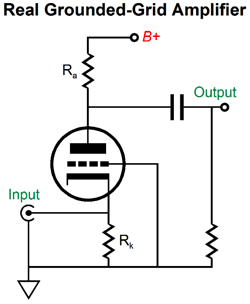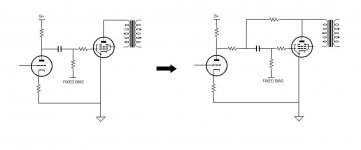Hi,
I was investigating about generic feedback and its use and I ran into a particular local feedback loop between grid and cathode of a tube (triode, ecc.). I noticed it's employed especially in certain guitar amps. I wondered if it has any use in tube audio systems too. And how to calculate the the proper cut-off frequency for a generic case. Some informations of the subject are messy.
I was investigating about generic feedback and its use and I ran into a particular local feedback loop between grid and cathode of a tube (triode, ecc.). I noticed it's employed especially in certain guitar amps. I wondered if it has any use in tube audio systems too. And how to calculate the the proper cut-off frequency for a generic case. Some informations of the subject are messy.
Attachments
That appears to be feedback between anode and grid. Sometimes nowadays called "Schade" feedback, although it is actually just ordinary voltage series feedback. See any description of opamp inverting mode.
It really bugs me when people call parallel applied voltage feedback "Schade" feedback since O.H. Schade used series applied voltage feedback in his paper, but I guess at some point if enough people use a word incorrectly, the definition changes and they become correct. I'll go along with it I guess, but I don't have to like it!
To work, there must be an input series resistor, or at least a significant output impedance from the previous stage. If driven by a voltage source, the feedback resistor would have no effect.
SpreadSpectrum,
Thanks for enlightening me about the mis-nomer of applying the term "Schade" feedback.
I have a similar gripe, those who call a long tailed phase splitter a Grounded Grid Amp.
I'm just an old school person.
Thanks for enlightening me about the mis-nomer of applying the term "Schade" feedback.
I have a similar gripe, those who call a long tailed phase splitter a Grounded Grid Amp.
I'm just an old school person.
SpreadSpectrum,
Thanks for enlightening me about the mis-nomer of applying the term "Schade" feedback.
I have a similar gripe, those who call a long tailed phase splitter a Grounded Grid Amp.
I'm just an old school person.
People call an LTP a grounded-grid amp? 😱
You can find information here The Valve WizardHi,
I was investigating about generic feedback and its use and I ran into a particular local feedback loop between grid and cathode of a tube (triode, ecc.). I noticed it's employed especially in certain guitar amps. I wondered if it has any use in tube audio systems too. And how to calculate the the proper cut-off frequency for a generic case. Some informations of the subject are messy.
Yes, this is what J. Broskie - among others I guess - also points out More Hybrid-Amplifier Design Although I understand the high source impedance mechanism and the related formulae, I wonder why in the low source impedance scenario the feedback resistor won't have any effect. OK, the formulae won't apply, but still a feedback loop. What do I miss?To work, there must be an input series resistor, or at least a significant output impedance from the previous stage. If driven by a voltage source, the feedback resistor would have no effect.
A very low source impedance (with no series resistor) shorts the feedback signal current to ground,
instead of developing a feedback voltage proportional to that current.
instead of developing a feedback voltage proportional to that current.
Last edited:
Yes, that's how to do it. You need to consider the DC current through the feedback resistor, and whether it changes the operating point of the first stage (if there is no coupling capacitor in series with the feedback resistor, as is the case here).
Last edited:
Sorry, I got that wrong; it is actually shunt feedback.DF96 said:it is actually just ordinary voltage series feedback
Yes. I don't like the term "Schade feedback" because there is nothing special about it; it is just normal feedback. It linearises the output stage at the cost of delinearising the previous stage, which on balance may be worth doing.SpreadSpectrum said:I'll go along with it I guess, but I don't have to like it!
Thanks for enlighting me. I took a look on the link of Magicbus, something is clearer now...it seems to me to be "exotic" and poorly used though in hi-fi, as to reduce distortion compared to other ways (since you need to have strict conditions to respect).
Have a look at this thread perhaps it is of some help:Hi,
I was investigating about generic feedback and its use and I ran into a particular local feedback loop between grid and cathode of a tube (triode, ecc.). I noticed it's employed especially in certain guitar amps. I wondered if it has any use in tube audio systems too. And how to calculate the the proper cut-off frequency for a generic case. Some informations of the subject are messy.
Trying to solve a Plate Follower Problem
Especially the second pdf file on page 1
Well there is the RH84 and derivates, build many times.it seems to me to be "exotic" and poorly used though in hi-fi, as to reduce distortion compared to other ways (since you need to have strict conditions to respect).
Mona
Transfomer Impedance.
So, given the discussion above, my understanding is that when using local feedback on the output tubes reduce the "effective" plate impedance.
I guess the same effect will be present when using CFB or feedback from output plates to input sage (E.g. Baby Huey)
Will such use of local feedback have any effect on choice of transformer ratio/ plate load?
So, given the discussion above, my understanding is that when using local feedback on the output tubes reduce the "effective" plate impedance.
I guess the same effect will be present when using CFB or feedback from output plates to input sage (E.g. Baby Huey)
Will such use of local feedback have any effect on choice of transformer ratio/ plate load?
Back to starting pointWell there is the RH84 and derivates, build many times.
Mona
 RH84 seems to have plate to grid feedback without a resistor in series with the low Zout driver. How does this work?
RH84 seems to have plate to grid feedback without a resistor in series with the low Zout driver. How does this work?- Home
- Amplifiers
- Tubes / Valves
- Local feedback between grid-cathode


